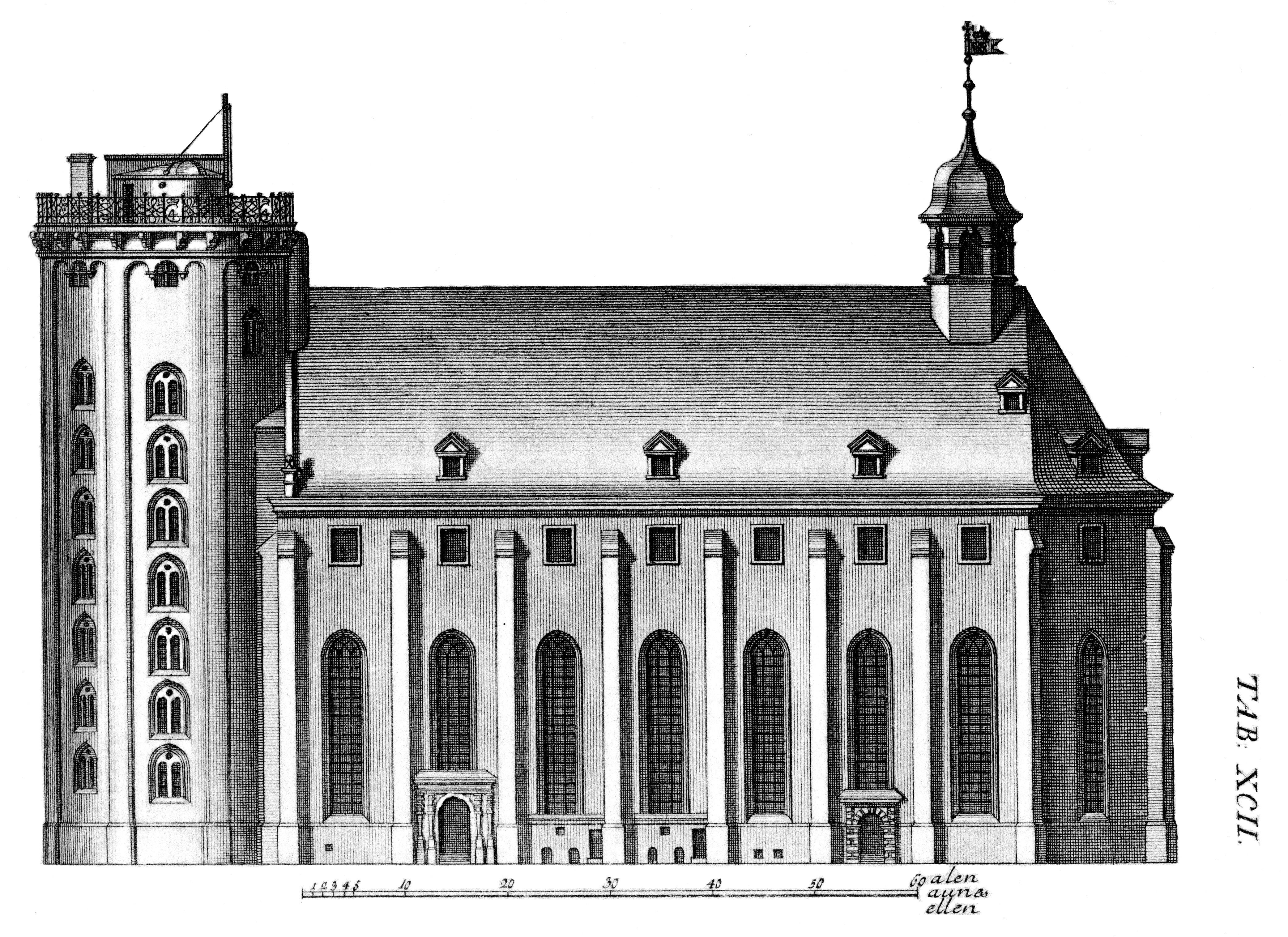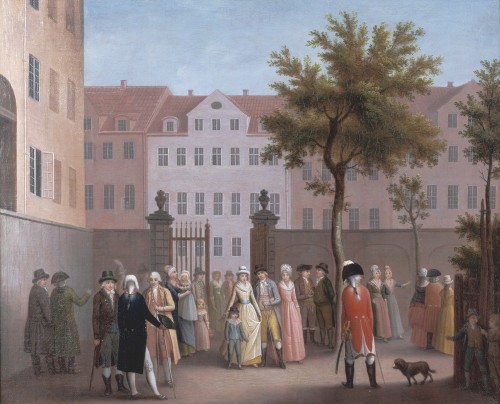|
Landemærket
Landemærket, literally "The Landmark", is a street in the Old Town of Copenhagen, Denmark. It extends from Købmagergade along the north side of the Trinitatis Complex (Round Tower and Trinitatis Church, Guttenberghus and the Film House to Gothersgade at Rosenborg Castle Gardens. History The name Landemærket reflects the topographical situation in the late 16th century when the street marked the transition between the built-up area of the city and the last undeveloped lots within the city walls. On 23 October 1665, the last block of the street was called Slippen until 1873. The oldest surviving accounting records from Trinitatis Church lists an expense for "a hasp on the gate in the fence towards Landemerchett (German spelling)". The street was from 1798 home to a row of small shops which were established along the wall that surrounded Trinitatis Church's graveyard to create an extra income for the church. They sold various goods, including tea and coffee, porcelain, sto ... [...More Info...] [...Related Items...] OR: [Wikipedia] [Google] [Baidu] |
Trinitatis Church
The Trinitatis Church (''Trinitatis Kirke'') is located in central Copenhagen, Denmark. It is part of the 17th century Trinitatis Complex, which includes the Rundetårn astronomical observatory tower and the Copenhagen University Library, in addition to the church. Built in the time of Christian IV, the church initially served the students of Copenhagen University. It is situated at the corner of Landemærket and Købmagergade. The interior was seriously damaged in the fire of 1728 but was rebuilt in 1731. , Visit Copenhagen. Retrieved 16 December 2012. History Initial plans in 1635 were for a student church at Regensen, the[...More Info...] [...Related Items...] OR: [Wikipedia] [Google] [Baidu] |
Copenhagen Business Academy
Copenhagen Business Academy, also known as Cphbusiness, is a school of higher education in Copenhagen, Denmark. The academy is an independent self-owning institution subordinated to the Ministry of Science, Innovation and Higher Education. Degree programmes offered are mainly applied degrees, especially in business, finance, service management, IT and biotechnical science. The academy grants undergraduate and academic degrees but not master's or doctoral degrees. In addition to full-time studies the academy offers supplemental education, part-time programmes at bachelor's level and short-term courses for people who need to strengthen their qualifications. The academy is one of the largest business academies in Denmark. The academy has 4.800 full-time students and 5.800 part-time students and about 350 employees. History Copenhagen Business Academy was founded in 2009 and initially offered higher education programmes in cooperation with Niels Brock Copenhagen Business College, Cope ... [...More Info...] [...Related Items...] OR: [Wikipedia] [Google] [Baidu] |
Møntergade
Møntergade ( lit. "Minter Street") is a street in the Old Town of Copenhagen, Denmark. It runs from Pilestræde in the west to Gothersgade in the east. History Møntergade has probably existed since the Middle Ages but the first reference to the street is from 1528 when it is referred to as "the city's street which runs to the rampart ("byes stræde, som løuer till wollen"), a reference to the city's East Rampart which then followed the course of present-day Gothersgade. The current name of the street is first recorded in 1623. It refers to the Royal Mint which took over St. Clare's Monastery after it was confiscated by the crown during the Reformation. In 15659, most of the residents in the street were craftsmen such as carpenters, weaversn coopers, wood carvers, wheelwrights, glove makers and basket makers. Poul Fechtel, who had been Royal Mint Master from 1536 until 1565, created a charitable housing development on a lot granted by the king in 1570. It became known as P ... [...More Info...] [...Related Items...] OR: [Wikipedia] [Google] [Baidu] |
Rosenborg Castle Gardens
Rosenborg Castle Gardens (Danish: ''Kongens Have''; literally ''The King's Garden'') is the oldest and most visited park in central Copenhagen, Denmark. Established in the early 17th century as the private gardens of King Christian IV of Denmark, Christian IV's Rosenborg Castle, the park also contains several other historical buildings, including Rosenborg Barracks, home to the Royal Life Guards (Denmark), Royal Guards, as well as a high number of statues and monuments. The park also holds art exhibitions and other events such as concerts in the summer. History The Renaissance gardens The park traces its history back to 1606 when King Christian IV of Denmark, Christian IV acquired land outside Copenhagen's East Rampart and established a pleasure garden in Gardens of the French Renaissance, Renaissance style which also delivered fruit, vegetables and flowers for the royal household at Copenhagen Castle. The garden had a relatively small pavilion which was later expanded into prese ... [...More Info...] [...Related Items...] OR: [Wikipedia] [Google] [Baidu] |
Pilestræde
Pilestræde ( lit. English: Willow Alley) is a street in central Copenhagen, Denmark. It is a side street to the pedestrianized shopping street Strøget and commonly associated with the newspaper publishing house Berlingske Media, which has its headquarters in the street. History The street name refers to Pilegården, a farm which was located at the site in the Middle Ages. Pilegårde is first mentioned in 1419 and was divided into several smaller properties in 1579. In the 16th century, Copenhagen's stud farm (''Københavns Avlsgård''), where the city's bulls were stabled, was also located along the street. The stud farm was in 1671 sold to Trinitatis Church for use as a cemetery. The northernmost part of Pilestræde was originally called Springergade with a reference to the bulls at the farm. Local residents found the name inappropriate and the street was therefore included in Pilestræde in 1881. In 1765, Berlingske's publishinghouse established in one of the yards on the ... [...More Info...] [...Related Items...] OR: [Wikipedia] [Google] [Baidu] |
Copenhagen
Copenhagen ( ) is the capital and most populous city of Denmark, with a population of 1.4 million in the Urban area of Copenhagen, urban area. The city is situated on the islands of Zealand and Amager, separated from Malmö, Sweden, by the Øresund strait. The Øresund Bridge connects the two cities by rail and road. Originally a Vikings, Viking fishing village established in the 10th century in the vicinity of what is now Gammel Strand, Copenhagen became the capital of Denmark in the early 15th century. During the 16th century, the city served as the ''de facto'' capital of the Kalmar Union and the seat of the Union's monarchy, which governed most of the modern-day Nordic countries, Nordic region as part of a Danish confederation with Sweden and Norway. The city flourished as the cultural and economic centre of Scandinavia during the Renaissance. By the 17th century, it had become a regional centre of power, serving as the heart of the Danish government and Military history ... [...More Info...] [...Related Items...] OR: [Wikipedia] [Google] [Baidu] |
Danish Film Institute
The Danish Film Institute (; DFI) is the national Danish institution, agency responsible for supporting and encouraging film and cinema culture, and for conserving these in the national interest. It is the successor organisation to the Danish Film Foundation (Danish: Den Danske Filmfond). Also known as ''Filmhuset'' ("the film house"), it is located in Gothersgade in central Copenhagen. Facilities directed at the general public include a library and Cinemateket, Denmark's national film museum. was appointed to take over from current director of the institute, Claus Ladegaard, from 1 August 2024. History The Danish Film Institute was founded in 1972, replacing the Danish Film Foundation (Danish: Den Danske Filmfond). In 1996 a new Danish Film Act merged the Film Institute with Statens Filmcentral and the National Danish Film Museum with effect from the following year and at the same event the institution relocated to its current premises at Filmhuset in Gothersgade. Activities ... [...More Info...] [...Related Items...] OR: [Wikipedia] [Google] [Baidu] |
Denmark
Denmark is a Nordic countries, Nordic country in Northern Europe. It is the metropole and most populous constituent of the Kingdom of Denmark,, . also known as the Danish Realm, a constitutionally unitary state that includes the Autonomous administrative division, autonomous territories of the Faroe Islands and Greenland in the north Atlantic Ocean.* * * Metropolitan Denmark, also called "continental Denmark" or "Denmark proper", consists of the northern Jutland peninsula and an archipelago of 406 islands. It is the southernmost of the Scandinavian countries, lying southwest of Sweden, south of Norway, and north of Germany, with which it shares a short border. Denmark proper is situated between the North Sea to the west and the Baltic Sea to the east.The island of Bornholm is offset to the east of the rest of the country, in the Baltic Sea. The Kingdom of Denmark, including the Faroe Islands and Greenland, has roughly List of islands of Denmark, 1,400 islands greater than in ... [...More Info...] [...Related Items...] OR: [Wikipedia] [Google] [Baidu] |
Egmont Group
The Egmont Group (officially Egmont International Holding A/S; known as Gutenberghus Group until 1992) is a Danish media corporation founded and rooted in Copenhagen, Denmark. The business area of Egmont has traditionally been magazine publishing, but has over the years evolved to comprise mass media generally. History The Egmont Group was founded by Egmont Harald Petersen in 1878, as a one-man printing business, but soon became a magazine business. It was originally called "P. Petersen, Printers", named after Petersen's mother, as he was still too young at the time to register his own company. The company was renamed ''Gutenberghus'' in 1914 (after the famous inventor of the printing press), a name it kept until 1992. In 1948, Gutenberghus, looking for new opportunities, sent its editor Dan Folke to Walt Disney Productions, and he managed to acquire a license for publishing comic magazines in Scandinavia. In 1948, the company started to publish a Donald Duck comic magazine ... [...More Info...] [...Related Items...] OR: [Wikipedia] [Google] [Baidu] |

